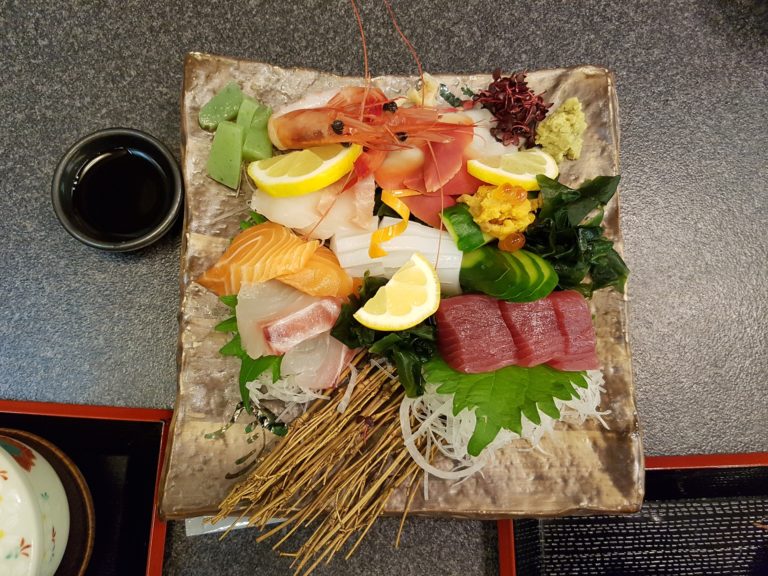
There is a pretty good reason why Japanese food is one of the best cuisines in the whole world. Washoku – Japanese cooking emphasizes balance and variety. This amazing cooking is achieved with using 5 colors (green, yellow, red, white and black), 5 techniques (frying, boiling, steaming, grilling and raw food) and also 5 different flavors (bitter, sour, salty, spicy and sweet).
What’s interesting is that you might even find these principles in just one meal, like three sides, soup, and rice. Now you see why Japanese cuisine is prized, and if you are one of many people who enjoy home cooked Japanese meals you must have the right introduction to their signature ingredients.
Wasabi: This is a root that is used in sushi as a condiment. It has a hot and strong flavor. It can be bought as a paste or in tins as powder. However, traditionally it is grated before eating.
Wakame: Seaweed with a somewhat sweet flavor.
Udon noodles: These are thick neutral flavor wheat noodles.
Sushi Vinegar: This is vinegar that is used to flavor cooked rice for sushi. This vinegar is, in fact, rice vinegar but it contains sugar and salt.
Soy Sauce: Today almost all households have this sauce. It is made from boiled soybeans, which are then roasted, grained and then brined. Its basic taste is known as umami, a savory and pleasant taste. However, there are 5 different types and each has its own difference ingredients and also a different production method.
- Saishikomi: This is twice brewed sauce, it is darker and has a stronger flavor
- Shiro: Translated means white. Compared to Thamari, this one is mostly wheat and less soybean. This gives it a sweet taste and light appearance.
- Tamari: a richer and darker compared to Koikuchi and it is used usually for sashimi. The best part about Tamari is that it can be sued by people who have gluten intolerance. In fact, it is also considered as an “original” soy sauce because it is very similar to soy sauce.
- Usukuchi: it is a type with weaker taste. It is plain and saltier soy sauce and also light in color (when compared to koikuchi.
- Koikuchi: A thick flavored soy sauce, which has a lot of soy sauce (about 80%). In fact, this is the plain or standard type that you can find in Japanese restaurants.
Soda Noodles: Made from buckwheat with a rich nutty flavor. Some might have wheat in them. Make sure to check the label if you are looking for gluten-free.
Sake: Alcoholic beverage that is traditional to Japanese culture. In some cases, it is called rice wine because the base is fermented rice. The two types are “Tokutei meisho-shu” and “Futsu – shu”. “Futsu – shu” is a table wine, while “Tokutei meisho – shu” is a premium variety.
Rice Vinegar: The Japanese version of rice vinegar is not so strong compared to Chinese rice vinegar. It has a sweet and very milk flavor. Used for flavoring sushi, plain rice or other similar dishes.
Rice: Japanese cuisine uses only short grain rice.
Ramen: These are long noodles made from wheat.
Potato Starch: This starch is gluten-free and highly white. It used for absorbing excess moisture because it has a neutral taste. Also, it gives that crunch factor to tempura.
Nori: Seasoned and toasted edible seaweed. It is used for sushi and onigiri. It is also used for noodle and soups as a garnish.
Miso: A seasoning paste made from barley, rice and/or soybeans. It is perfect for soups, and salad dressings. You can find three different miso, red, white and mixed. Each has its own appearance, texture, and flavor. The white is sweeter compared to the mixed and red.
Mirin: Essential condiment (wine) made from sticky rice. It is used for cooking.
Kombu: Dried kelp, perfect for dashi stock. In appearance is thicker than the nori. But it shouldn’t be consumed because it requires reconstituting in warmer water before use.
Furikake: Dried condiment that is sprinkled over rice. It is made from ground and dried seaweed, sesame seeds, fish, and salt.
Dried Shiitake: This is one amazing edible mushroom. It is native and it is prized for its flavor.
Daikon: With lightly peppery flavor, daikon can be pickled, cooked or eaten raw.
From now on you are ready to start preparing Japanese traditional food. Let the tasty aroma spread through your home. As a Japanese food lover you probably already know what dish you will make after learning about the basic but very important Japanese ingredients.